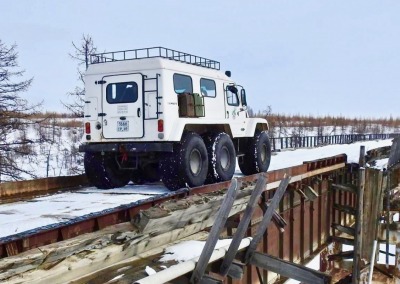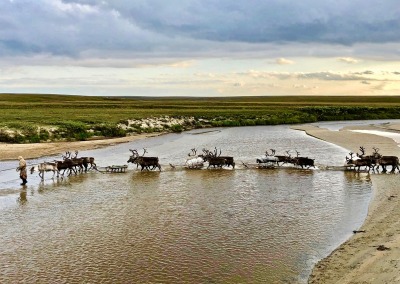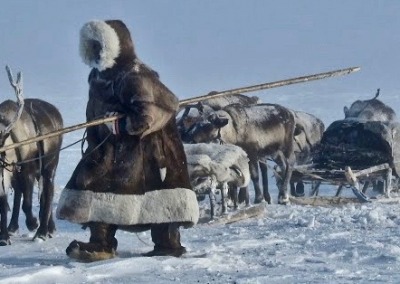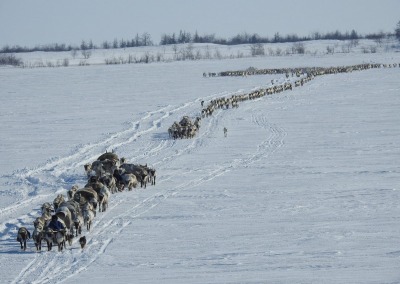Nomadic migrations
Nenets migrations are truly one of the most spectacular events that one can witness on our planet. Imagine 11,000 reindeer, 100 wooden sledges and 50 people snaking across the landscape in a caravan up to 8km long. Even the most experienced Arctic film-makers and tribal photographers often find it a life-changing experience.
The whole process of a migration usually takes 8 – 12 hours. After breakfast the women start taking down the chum (reindeer-fur tepee) and packing it onto sledges along with all the family’s possessions. Each family usually has 14 – 15 sledges, which get connected up into two trains of sledges called argish.
Meanwhile, the men go out to round up the reindeer, which can be several kilometres from the camp. They drive the herd back to camp and separate the trained, castrated transport reindeer from all others. If a transport deer tries to escape with the others, they lasso it with their reindeer rawhide lassoes.
Once they are separated, they drive the transport reindeer into a temporary coral made of sledges laid out in a horseshoe shape, with a fishing net spread above them and hanging from poles driven into the ground. The people then go in among the jostling reindeer to search for their own ones to harness to their sledges. The front sledge in each argish (sledge train) is pulled by four reindeer, while all the sledges behind it are pulled by two.
This stage of the day is an amazing demonstration of how each man must recognise all his reindeer by their faces and fur patterns, as he is only allowed to use his own. Even when thousands of reindeer are stampeding past, every Nenets at the camp will be able to pick out his own at a distance of up to 15 metres and throw his lasso accurately enough to get caught on its antlers or hind legs.
After several hours everything is ready. Families sit on the snow to drink some tea and have a snack before setting off. The women drive the argishi (sledge trains), which move very slowly, while men ride single reindeer sledges and drive the reindeer herd. In winter these days, men more often use snowmobiles for this, whereas in summer it is done only on reindeer sledges.
The migration demonstrates the strict division of labour between the sexes. Men are, as always, only concerned with the reindeer. The women, on the other hand, are only concerned with the chum, food, possessions and children, all of which are transported on the argish.
A migration in summer is usually around 5 – 10km. Ground is swampy and it is harder for reindeer to pull sledges, so longer migrations are not possible. In winter, migrations are usually between 10km and 30km, as it is easier for the reindeer on snow and ice.
Twice a year the Yar-Sale Nenets also do a very long migration of between 50km and 100km. This is when they cross the Gulf of Ob, a bay of the Arctic Ocean that separates the Yamal Peninsula from Nadym District. The southwards crossing is done around New Year and the northwards crossing in early to mid-April. This must be done in one go, without camping on the ice, as there is of course no food for the reindeer there. The northwards crossing in April’s warmer weather can be very pleasant. The southwards crossing in January temperatures, which can reach -60°C, can be an absolute nightmare. The whole migration takes up to 24 hours, much of which is spent out on the ice with winds howling straight down the Gulf of Ob from the North Pole.
Upon arriving at a new campsite the head of the camp sticks his herding pole in the ground to indicate where the fireplace (central spot) of his chum will be. Sledges are unloaded, reindeer unharnessed and the chum is set up. People go out to cut down trees for firewood if there are any nearby, and to collect snow or ice for tea. Once the chum is set up, a fire is lit and snow is shovelled around the outside to insulate the gap between the chum covers and the ground.
If joining the Nenets on their epic migrations is your main goal, you need to choose carefully both the time of year and the area to visit. All Nenets groups stop migrating in mid-winter for a period of between 1.5 and 7 months, depending on the area. If you visit Nenets within a day’s travel from Salekhard city, in the Polar Ural Mountains or near Yorkuta you are unlikely to see a migration unless you pay the Nenets to do it especially for you.
The only area you should choose if migrating is your main goal is the Yar-Sale area. These Nenets have the longest migration routes (up to 2000km each year), which means they migrate the most often. They stop migrating only for 1.5 to 4 months in winter. Throughout the rest of the year they migrate 2 – 3 times a week. They also have the largest reindeer herds: all the groups we visit have between 3,000 and 11,000 reindeer. Their traditional culture is also somewhat better preserved than that of Nenets in the mountains and nearer to Salekhard.
To join these Nenets at a time when they are accessible by ground transport and are sure to be migrating, the best times of year are: November 15th – January 15th, March 15th – May 15th and July 15th – August 31st.
If visiting Nenets in other areas, you will be much less likely to see a natural migration. However, as the camps in other areas generally have far fewer reindeer (hundreds as opposed to thousands) and chums (1 – 3 as opposed to 5 – 8), they are occasionally able to stage a migration for guests if paid extra. However, with so few reindeer and chums it is of course not as impressive as a genuine migration with the Yar-Sale Nenets.
Nenets migrations are truly one of the most spectacular events that one can witness on our planet. Imagine 11,000 reindeer, 100 wooden sledges and 50 people snaking across the landscape in a caravan up to 8km long. Even the most experienced Arctic film-makers and tribal photographers often find it a life-changing experience.
The whole process of a migration usually takes 8 – 12 hours. After breakfast the women start taking down the chum (reindeer-fur tepee) and packing it onto sledges along with all the family’s possessions. Each family usually has 14 – 15 sledges, which get connected up into two trains of sledges called argish.
Meanwhile, the men go out to round up the reindeer, which can be several kilometres from the camp. They drive the herd back to camp and separate the trained, castrated transport reindeer from all others. If a transport deer tries to escape with the others, they lasso it with their reindeer rawhide lassoes.
Once they are separated, they drive the transport reindeer into a temporary coral made of sledges laid out in a horseshoe shape, with a fishing net spread above them and hanging from poles driven into the ground. The people then go in among the jostling reindeer to search for their own ones to harness to their sledges. The front sledge in each argish (sledge train) is pulled by four reindeer, while all the sledges behind it are pulled by two.
This stage of the day is an amazing demonstration of how each man must recognise all his reindeer by their faces and fur patterns, as he is only allowed to use his own. Even when thousands of reindeer are stampeding past, every Nenets at the camp will be able to pick out his own at a distance of up to 15 metres and throw his lasso accurately enough to get caught on its antlers or hind legs.
After several hours everything is ready. Families sit on the snow to drink some tea and have a snack before setting off. The women drive the argishi (sledge trains), which move very slowly, while men ride single reindeer sledges and drive the reindeer herd. In winter these days, men more often use snowmobiles for this, whereas in summer it is done only on reindeer sledges.
The migration demonstrates the strict division of labour between the sexes. Men are, as always, only concerned with the reindeer. The women, on the other hand, are only concerned with the chum, food, possessions and children, all of which are transported on the argish.
A migration in summer is usually around 5 – 10km. Ground is swampy and it is harder for reindeer to pull sledges, so longer migrations are not possible. In winter, migrations are usually between 10km and 30km, as it is easier for the reindeer on snow and ice.
Twice a year the Yar-Sale Nenets also do a very long migration of between 50km and 100km. This is when they cross the Gulf of Ob, a bay of the Arctic Ocean that separates the Yamal Peninsula from Nadym District. The southwards crossing is done around New Year and the northwards crossing in early to mid-April. This must be done in one go, without camping on the ice, as there is of course no food for the reindeer there. The northwards crossing in April’s warmer weather can be very pleasant. The southwards crossing in January temperatures, which can reach -60°C, can be an absolute nightmare. The whole migration takes up to 24 hours, much of which is spent out on the ice with winds howling straight down the Gulf of Ob from the North Pole.
Upon arriving at a new campsite the head of the camp sticks his herding pole in the ground to indicate where the fireplace (central spot) of his chum will be. Sledges are unloaded, reindeer unharnessed and the chum is set up. People go out to cut down trees for firewood if there are any nearby, and to collect snow or ice for tea. Once the chum is set up, a fire is lit and snow is shovelled around the outside to insulate the gap between the chum covers and the ground.
If joining the Nenets on their epic migrations is your main goal, you need to choose carefully both the time of year and the area to visit. All Nenets groups stop migrating in mid-winter for a period of between 1.5 and 7 months, depending on the area. If you visit Nenets within a day’s travel from Salekhard city, in the Polar Ural Mountains or near Yorkuta you are unlikely to see a migration unless you pay the Nenets to do it especially for you.
The only area you should choose if migrating is your main goal is the Yar-Sale area. These Nenets have the longest migration routes (up to 2000km each year), which means they migrate the most often. They stop migrating only for 1.5 to 4 months in winter. Throughout the rest of the year they migrate 2 – 3 times a week. They also have the largest reindeer herds: all the groups we work with have between 3,000 and 11,000 reindeer. Their traditional culture is also somewhat better preserved than that of Nenets in the mountains and nearer to Salekhard.
To join these Nenets at a time when they are accessible by ground transport and are sure to be migrating, the best times of year are: November 15th – January 15th, March 15th – May 15th and July 15th – August 31st.
If visiting Nenets in other areas, you will be much less likely to see a natural migration. However, as the camps in other areas generally have far fewer reindeer (hundreds as opposed to thousands) and chums (1 – 3 as opposed to 5 – 8), they are occasionally able to stage a migration for guests if paid extra. However, with so few reindeer and chums it is of course not as impressive as a genuine migration with the Yar-Sale Nenets.




